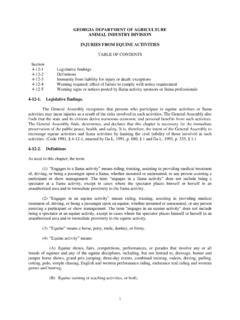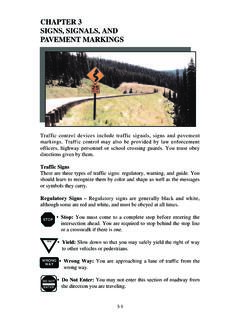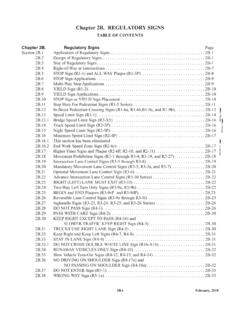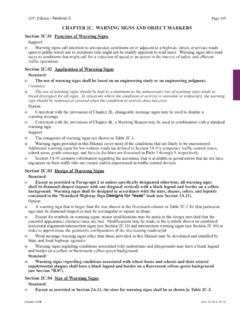Transcription of Chapter 4: Protecting Children - Child Welfare
1 37 2018 Prevention Resource GuideChapter 4: Protecting Children When Children are nurtured, they can grow up to be happy and healthy adults. But when they lack an attachment to a caring adult, receive inconsistent nurturing, or experience harsh discipline, the consequences can affect their lifelong health, well-being, and relationships with others. This Chapter provides information to help service providers and others concerned about the health and well-being of Children to understand Child abuse and neglect, its effects, and what each of us can do to address it when it occurs. What Is Child Abuse and Neglect? Child abuse or neglect often takes place in the home at the hands of a person the Child knows well a parent, relative, babysitter, or friend of the family. There are four major types of Child maltreatment. Although any of the forms may be found separately, they often occur together. Each state is responsible for establishing its own definitions of Child abuse and neglect that meet federal minimum standards.
2 Most include the following: Neglect is failure to provide for a Child s basic needs. Physical abuse is physical injury as a result of hitting, kicking, shaking, burning, or otherwise harming a Child . Sexual abuse is any situation where a Child is used for sexual gratification. This may include indecent exposure, fondling, rape, or commercial exploitation through prostitution or the production of pornographic materials. Emotional abuse is any pattern of behavior that impairs a Child s emotional development or sense of self-worth, including constant criticism, threats, and rejection. Trafficking is another type of Child maltreatment. States are required to consider any Child who is identified as a victim of sex trafficking or severe forms of trafficking (as defined in the Trafficking Victims Protection Act) as a victim of Child abuse and neglect and sexual abuse. The term sex trafficking means the recruitment, harboring, transportation, provision, or obtaining of a person for the purpose of a commercial sex act.
3 The term severe forms of trafficking in persons means sex trafficking in which a commercial sex act is induced by force, fraud, or coercion, or in which the person induced to perform such act has not attained 18 years of age. Why Does Child Abuse Occur? Child abuse and neglect affect Children of every age, race, and income level. However, research has identified many factors relating to the Child , family, community, and society that are associated with an increased risk of Child abuse and neglect. Studies also have shown that when multiple risk factors are present, the risk is Understanding Child Abuse and Neglect 38 Some of the most common risk factors include the following: I m m at u r it y. Young parents may lack experience with Children or be unprepared for the responsibility of raising a Child . Unrealistic expectations. A lack of knowledge about normal Child development or behavior may result in frustration and, ultimately, abusive discipline.
4 Stress. Families struggling with poverty, unstable housing, divorce, or unemployment may be at greater risk. Substance use. The effects of substance use, as well as time, energy, and money spent obtaining drugs or alcohol, significantly impair parents abilities to care for their Children . Intergenerational trauma. Parents own experiences of childhood trauma impact their relationships with their Children . Isolation. Effective parenting is more difficult when parents lack a supportive partner, family, or circumstances, combined with the inherent challenges of raising Children , can result in otherwise well-intentioned parents causing their Children harm or neglecting their needs. On the other hand, evidence shows that the great majority of families who experience these circumstances will not abuse or neglect their Children . Protective factors, such as the ones discussed in this Resource Guide, act as buffers to help many families who are under stress parent Many Children Are Abused and Neglected in the United States?
5 In federal fiscal year (FFY) 2016, the most recent year for which national Child maltreatment statistics are available, about million reports were made to Child protective services concerning the safety and well-being of approximately million a result of these reports, a nationally estimated 676,000 (unique count) Children were found to be victims of Child abuse or neglect. (Unique count is defined as counting each Child only once regardless of the number of reports of abuse and neglect.) Of these Children , three-quarters ( percent) were neglected, more than 18 percent ( percent) were physically abused, and fewer than 10 percent ( percent) were sexually deaths are the most tragic results of maltreatment. In FFY 2016, an estimated 1,750 Children died due to abuse or neglect. Of the Children who died, and for whom Child -specific data were reported, percent suffered neglect and percent suffered physical abuse either exclusively or in combination with another maltreatment What Are the Consequences?
6 Child maltreatment is a traumatic experience, and the impact on survivors can be profound. Traumatic events, whether isolated ( , a single incident of sexual abuse) or ongoing ( , chronic emotional abuse or neglect), overwhelm Children s ability to cope and elicit powerful 1 Statistics on this page are taken from the Department of Health and Human Services, Children s Bureau. (2018). Child Maltreatment 2016. Retrieved from 39 2018 Prevention Resource Guidephysical and emotional responses. These responses continue even when the danger has passed, often until treatment is events may impair a Child s ability to trust others, their sense of personal safety, and effectiveness in navigating life changes. Research shows that Child maltreatment, like other trauma and adverse childhood experiences (ACEs), is associated with poor physical health and mental health outcomes in Children and families, and those negative effects can last a trauma of Child abuse or neglect has been associated with increased risk of the following: Depression and suicide attempts Substance use Developmental disabilities and learning problems Social problems with other Children and with adults Te e n pr e g n a nc y Lack of success in school Domestic violence Chronic illnesses, including heart disease, cancer, and lung disease, among othersIn addition to the impact on the Child and family, Child abuse and neglect affect the community as a whole including medical and mental health, law enforcement, judicial, public social services, and nonprofit agencies as they respond to incidents and support victims.
7 The CDC estimates that the confirmed cases of Child maltreatment from just 1 year cost the nation approximately $124 billion over the victims Are the warning signs ?The first step in helping or getting help for an abused or neglected Child is to identify the symptoms of table below lists some symptoms of the four major types of Child maltreatment. The presence of a single sign does not prove that Child abuse is Maltreatment TypeSymptoms Neglect Signs of malnutrition Poor hygiene Unattended physical or medical problems Physical abuse Unexplained bruises, burns, or welts Child appears frightened of a parent or caregiver Sexual abuse Pain, bleeding, redness, or swelling in anal or genital area Age-inappropriate sexual play with toys, self, or others Age-inappropriate knowledge of sex Emotional abuse Extremes in behavior, ranging from overly aggressive to overly passive Delayed physical, emotional, or intellectual development 2 Fang, X.
8 , Brown, D. S., Florence, C. S., & Mercy, J. A. (2012). The economic burden of Child maltreatment in the United States and implications for prevention. Child Abuse & Neglect, 36(2), 156 165. 40 in a family; however, when these signs appear repeatedly or in combination, you should consider the possibility of Can I Do If I Suspect Child Abuse or Neglect?Anyone can and should report suspected Child abuse or neglect. If you think a Child is being mistreated, take immediate states have a toll-free number for reporting. To find out how to make a report in your state, see the Information Gateway publication State Child Abuse and Neglect Reporting Numbers, at When you call to make a report, you will be asked for specific information, such as the following: The Child s name and location The name and relationship (if known) of the person you believe is abusing the Child What you have seen or heard regarding the abuse or neglect The names of any other people who might know about the abuse Your name and phone number (voluntary)Reporting the situation may protect the Child and get additional help for the family.
9 Many nonprofit, public, education, social service, and Child care organizations in your community play a role in providing supports and services to Children , youth, and families. Parenting education, crisis/respite care, transitional housing, and literacy programs as well as family resource centers, teen parent support groups, fatherhood groups, and marriage education classes support families in important Can I Help Children Who Have Been Abused or Neglected? Children who have experienced abuse or neglect need support from caring adults who understand the impact of trauma and how to help. Consider the following suggestions (see Adverse Childhood Experiences and Well- Being, on page 42, and the tip sheet, Helping Your Child Heal From Trauma, on page 93, for more information): Help Children feel safe. Support them in expressing and managing intense emotions. On the Child Welfare Information Gateway WebsiteFind more information about: Definitions of Child abuse and neglect: Risk and protective factors for Child abuse: How many Children are abused: warning signs : Responding to Child abuse and neglect: 2018 Prevention Resource GuideOn the WebAdverse Childhood Experiences Resources (CDC): of Child Abuse & Neglect (Information Gateway): Help Children understand their trauma history and current experiences (for example, by helping them understand that what happened was not their fault, or helping them see how their current emotions might be related to past trauma).
10 Assess the impact of trauma on the Child , and address any trauma-related challenges in the Child s behavior, development, and relationships. Support and promote safe and stable relationships in the Child s life, including supporting the Child s family and caregivers if appropriate. Often parents and caregivers have also experienced trauma. See Working With Parents Who Have a History of Trauma on page 44. Manage your own stress. Providers who have histories of trauma themselves may be at particular risk of experiencing secondary trauma symptoms. Find more information on the Information Gateway website at https : Refer the Child to trauma-informed services, which may be more effective than generic services that do not address trauma. 42 Are ACEs? Adverse childhood experiences (ACEs) are traumatic events occurring before age 18. ACEs include all types of abuse and neglect, as well as parental mental illness, substance use, divorce, incarceration, and domestic violence.



















